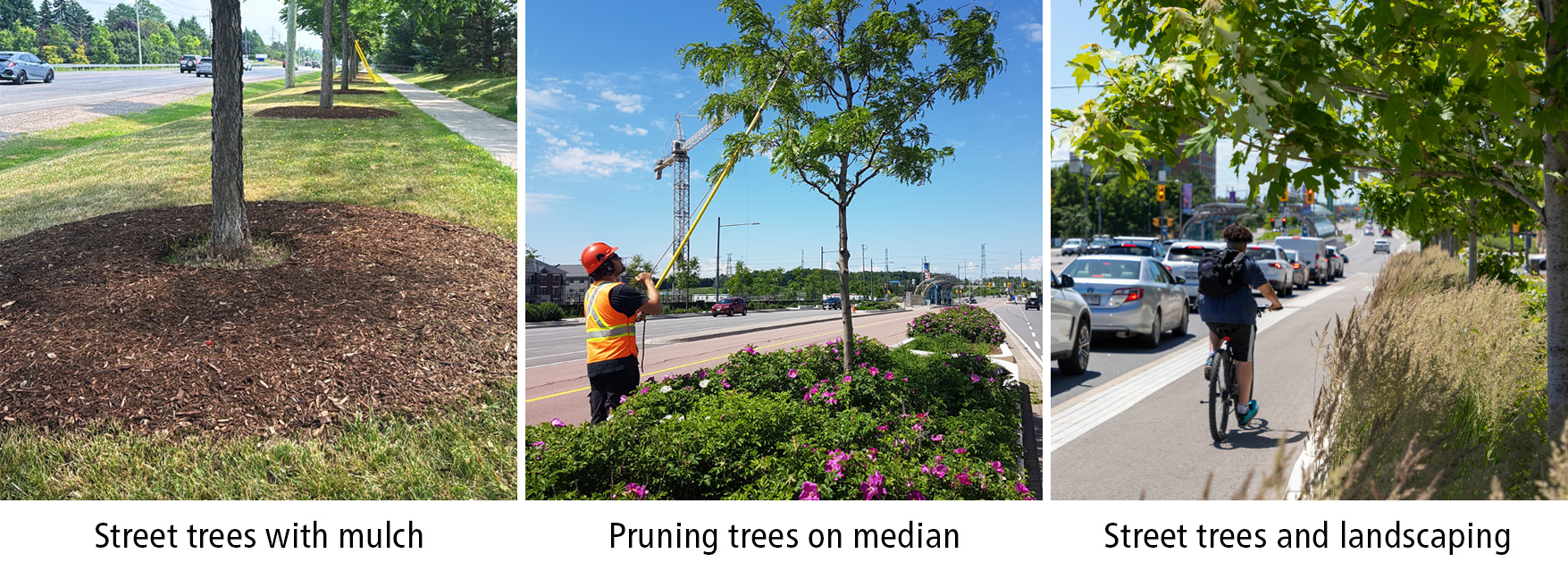Street Trees
Street trees include trees, shrubs, and plants planted along roadways and medians. They are part of the urban forest, which includes trees planted outside of forested areas.
Street trees contribute to the character of communities and:
- Improve air quality by absorbing pollutants
- Reduce urban heat through shade and cooling
- Manage stormwater by absorbing rainfall
- Support biodiversity by providing habitat
- Enhance mental well-being through access to nature
- Increase property values and beautify streets
- Encourage walking and cycling with shaded sidewalks
- Create a sense of place and community identity

York Region Street Trees
York Region plants and maintains street trees along Regional roads - main roadways that connect our nine local cities and towns to one another. Your city or town maintains them on municipal roads (your neighbourhood roads).
Street trees are a vital part of the Region’s green infrastructure. There are over 77,000 street trees planted along Regional roads. Each year York Region plants 1,500 to 2,000 street trees.
In 2025, York Region became the first municipality and the second organization in the world to be certified to the Sustainable Forestry Initiative (SFI) Urban and Community Forest Sustainability Standard.
Leadership and investments made in our street tree program contributed directly to receiving this certification. Achieving certification to this stringent third-party standard demonstrates the strength and maturity of the Region’s forestry program and value it brings to Region residents.
Frequently asked questions
What is the difference between a Regional road and a local municipal road?
Regional roads are typically main arterial roadways (e.g., Yonge Street, Dufferin Street, Highway 7, Major Mackenzie) that connect our nine local cities and towns to one another. They are operated and maintained by York Region. Each is identified by a numbered Regional road sign.
Local municipal roads are operated and maintained by local cities and towns
What kinds of trees and plants are currently used? How are they chosen?
The Region uses a mix of trees, shrubs and plants that are best suited to survive the harsh conditions of our local climate and Regional roadways. Chosen trees must also meet the constraints of the designated location, such as available space and/or proximity to utilities. Examples of commonly planted species include Kentucky Coffee Tree, Honey Locust and Ivory Silk Lilac (used under hydro lines).
How is it decided what type of tree is planted?
The Region has lists of top performers based on past performance. Based on these lists and site characteristics, qualified staff determine what will be planted at each location.
Why are there trees planted directly under power/hydro lines?
During planting, staff are mindful of overhead power lines. When overhead power lines are encountered, the Region plants low-growing species, such as the Ivory Silk Lilac to avoid future conflicts while still enhancing the streetscape.
Who does all the maintenance work on these trees/plants?
Maintenance is completed by contractors under the direction of York Region.
What is the future plan for plantings on Regional Roads?
York Region continues to expand the urban forest by increasing tree plantings along Regional roads. New plantings are planned during major road construction projects and follow streetscape master plans and York Region's Designing Great Streets Guidelines.
If I want to plant a tree, or need maintenance on an existing tree on my property, who can I contact?
Visit york.ca/TreePlanting to find the right tree-planting program for you.
If you need maintenance to an existing tree on your property, contact a private tree service provider. Please ensure they are qualified and insured, and be sure to consult with your local city or town as there may be local bylaws related to individual trees that may apply.


